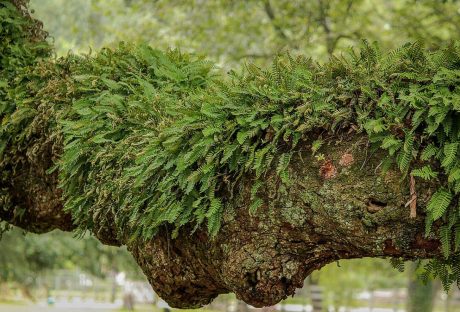Tag: Gardening Tips

All You Need To Know About Resurrection Plant And Its Facts
Selaginella lepidophylla, or resurrect plant, is a desert plant that belongs to the Spikemoss family, Selaginellaceae. Across the desert of Mexico and the United States, you will find this plant. However, it is considered that the desert of North Africa is the native place of this plant. It is also called the False Rose of Jericho. The creeping stems of this plant grow horizontally, and the leaves are like scale. What Is A Resurrection Plant? Any poikilohydric plant that is able to survive extreme dehydration is called a resurrection plant. These plants can survive without water for several months and even for years. For example, the Rose of Jericho, which is native to the North African deserts, is an example of the resurrection plant. The scientific name of this plant is Anastatica hierochuntica. Overview Of The Resurrection Plant Common NameResurrection plant, Rose of Jericho, false Rose of Jericho, stone flower, dinosaur plantBotanical NameSelaginella lepidophyllaFamilySelaginellaceaePlant TypePerennialMature Size2-6 in. tall, 3-6 in. wideSun ExposureFullSoil TypeNone neededHardiness Zones10Native AreaNorth America Some Interesting Facts About The Resurrection Plant Here are some interesting facts about the resurrection plant that will surely amaze you. Scaly Stems These plants have scaly stems that are arranged in the form of a rosette. A few stems that the resurrection plant produces always grow close to the ground. The entire plant covers a diameter of less than only 1 foot. Just like other plants, this plant also uses its roots in order to extract nutrients and water from the ground. Resurrection plant is a primitive plant that falls between the category of ferns and mosses. You can not see any leaves on the resurrection plant. All you will find are small, scaly extensions of stems that look like junipers. Absorb Water After rainfall, the resurrection plant quickly absorbs the water and enters the phase of rapid growth. As this plant is unable to accumulate water in the roots and stems, once the soil dries out, it also dries shortly. The dry plant curls up into a tight ball with a very small amount of water that is stored in the center.Though the curled ball looks like it is dead it is only dormant. During the whole period of dormancy, the plant minimizes metabolic activities and can last a few years or till the time of the next rain. Reviving Ability Due to its reviving ability, this plant is called a resurrection plant. This plant is able to rehydrate. Once it is exposed to moisture, after a few hours, it unfolds its stem and reactivates its metabolism. After it absorbs the water, the stem starts swelling and unfolds itself. Even if the stems do not have any live protoplast within them, this will indeed happen. “Siempre Viva,” which is another name for the resurrection plant. The phrase mentioned earlier means “everlasting.” Reproduce Sexually Resurrection plants do not produce flowers, fruits, and seeds. This plant reproduces sexually. Strobili, which is a club-like structure and produced via spores. 400 million years ago, this plant appeared on the planet. Most of the ancient lycopods were giant plants. But as a result of climate change, all of them became extinct. Small lycopods like resurrection plants have managed to survive without any morphological changes till the modern days. Dinosaur Plant Another name for the resurrection plant is the “Dinosaur plant" because it has lived side by side with dinosaurs. Tea made from the resurrection plant can treat sore throat and the common cold due to its antimicrobial properties. The resurrection plant is the longest-living plant on earth. Does the Resurrection Plant Need Soil? When you will buy a resurrection plant online or from your nearest nursery on the resurrection plant for sale, you will receive a brown ball of dried moss. This brown ball of moss does have roots, but the roots are not attached to anything. So, in order to grow, this miracle plant does not need soil. Similar to a hydroponic system, when there is no water or moisture for a really long time, the plant will curl into a ball and turn brown with a diameter of around 6 to 10 inches. which generally has a height range of 15 to 35 centimeters. This plant is very convenient in terms of taking care of and growing. Can a Resurrection Plant Die? From the earlier discussion, it may be clear that this plant is really hard to kill. You can simply put the plant in the dark corner of a room without water. But once you bring it out and leave it in water, it will get relieved once again. There is one way to kill this plant. That is overwatering. You can leave this plant in water for a few days, and it will start rotting, and eventually, it will die. How to Grow the Resurrection Plant? In order to grow and to care for a resurrection plant, all you need are: A broad and shallow container that should not have any drainage hole. Another wide container that should have drainage holes. For spreading at the button, gravel or pebbles. Distilled water at room temperature. A bright but shady place. And lastly, a dried resurrection plant. Process First, fill the wide and shallow container that has no drainage system with water. Do not fill it wholly. Put in two-thirds water. Place pebbles or gravel up to the waterline. Now, put the dried resurrection plant on the pebbles. For a completely dry and brown plant, it will take around 3 to 4 hours to turn green. Now, take the wide container that has drainage holes and spread the gravel or pebbles upto the level of water. Mix peat moss. Add humus and sand and spread it on the pebbles. Now, place the resurrected plant on the top. Do not place it in direct sunlight. Instead, place it in a shady place that has a temperature of higher than 40 degrees Fahrenheit. Once you notice the plant is getting brown, continue to water it. Conclusion This plant is super convenient for plant lovers who can not afford much time to take care of plants. Due to its relative properties, this plant can come back to life just after receiving water. That is why this brown dry ball of moss is so popular among plant lovers. More Resources:- DIY Ways To Control Pests In Your Garden Maintain A Bright And Beautiful Garden During Winter 5 Best Vegetables You Should Try Growing In Your Garden
READ MOREDetails
Smart Fun Gardening: How to Take Care of a Money Tree
The beauty of gardening is to see your seedlings grow into healthy beautiful plants. Some of the plants we grow in our homes have natural meanings attached to them while others we grow them to remind us of something special. Money tree which is also known as Pachira aquatic is a tree grown to symbolize prosperity and good luck. The money tree can grow up to 60 feet tall when it naturally grows outdoor, but when we decide to domesticate it, we limit its growth to 6 or 7 feet tall. There natively grow in South, and Central American swamps and you can determine the age of the tree by its size. In many customs of the world, the tree is linked to prosperity and positivity. It creates a positive aura that allows for economic benefits to flow into the family. However, caring and doing regular maintenance can become difficult for normal human beings and families. This is why a good idea is to opt for growing trees with Tree Service Stockton. They are professionals who can take care of everything from planting to regular pruning and fertilizers. This will ensure that your money tree will always be healthy. [caption id="attachment_3550" align="aligncenter" width="627"] Image of money tree that symbolizes prosperity[/caption] How to grow a money plant can be easy, but how to take care of the five trunks braided tree can be a challenge. The braided trunk is a symbol of a lock that locks in your prosperity and good luck. Here are tips on how to take care of a money tree: Where to Grow A smaller pot is preferred for the growth of your money tree because it regulates the growth of your tree and also controls water and fertilizer. Big pots make it easy for you to overwater the plant. Your pot should have a proper drainage system and if you suspect that’s not the case then drill more holes at the bottom of your pot. DynaPOT 2 Gallon Garden Planting Aeration Fabric Container is a nice choice because it is eco-friendly and has a perfect drainage system. Also, place your tree in a place with indirect light because direct sunlight makes the leaves vulnerable to scorching. However, if you notice that the leaves are turning yellow or withering then expose them to more light because that is an indication of light deficiency. Fluorescent light can do the magic if you are growing the tree inside your house or at the office. Glossy and healthy leaves of Pachira aquatic Money tree grows well in moderate to high humid regions that why they mostly grow in South and Central America. When you domesticate the plant regulate the humidity at about 50% and above. Wet pebbles are a great way of maintaining humidity for your plant all you need to do is place the pot on a basin with wet pebbles. Also, you have to retain the room temperature around 16-25°C. When there is no enough humidity in the room the plant will respond by turning its leaves dry crispy. Read also: Gardening Tips To Improve Outdoor Space 5 Essential Tips To Designing A Beautiful Front Yard Garden Fertilizer and Watering When it comes to domesticating the money tree, you get a challenge of water and fertilizer ratio and how often you should add them to the plant. This tree needs moist soil but not wet to grow well. So you will need to water it after 7-10 days or when you notice that the top 3-4 inches of the soil are dry. Then thoroughly water your plant until water comes from the drainage system, but you have to avoid watering up to the trunk because the stem may start to rot. However, you have to cut down on water during winter because the growth is slow at this time of the year. When you see the leaves of your plants turning yellow, and you have put them in the right lighting condition then it may be an indicator or overwatering your plant. [embed]https://www.youtube.com/watch?v=txHs21rkED0[/embed] How to grow and care for your money tree During spring and summer, you can add water-soluble fertilizer that is diluted by half after every two weeks. Whether you want to use an organic or inorganic fertilizer that’s a personal choice that does not have a significant impact on the plant. The Grow More 5010 All Purpose Fertilizer 20-20-20 is a multi-purpose fertilizer that contains all the micro and macronutrients your tree will need for healthy growth. Read also: Does Organic Gardening Improve Soil Quality? Pruning and Shaping Pruning is one of the easiest steps when it comes to taking care of your money plant. You can use a clean pair of scissors or prune shears to remove yellow or damaged leaves and also side branches that could disrupt the braiding process. The pruning process is usually done during spring and summer to allow the plant to produce new leaves. Image of a well braided Pachira aquatic Do the braiding (shaping) of the money tree while the plant is still young and flexible. In the wild nature takes its course and braids the tree at a particular stage. Continue braiding the tree as it grows and ties a knot at the end of the braid to secure it. Repotting As the tree grows the roots also grow, and that’s why it is recommended that you report your plant after every two years. However, when the tree has reached your desired size, you can just report in the same sized pot with fresh soil. Mix your soil with peat moss to help in retaining moisture and sand to help in drainage. Avoid moving the plant too much because it gets shocked and responds by losing leaves or leaves turning yellow. How to Propagate Propagation should be done during spring because the growth rate is at its peak during this season. Chose a stem that contains not less than two leaf nodes. Sanitize a pair of scissors or pruning shears and chop off the stem then place it in a hormone rooting powder. When you the stem is well-soaked place it in a well moist pot mix. Give it time because it takes several weeks to start rooting. [embed]https://www.youtube.com/watch?v=QlZVZkKy6IY[/embed] How to propagate money tree It is easier to take care of your money tree if you know the favored conditions and how to troubleshoot any problems. The Pachira aquatic gives out various signs if they are not satisfied with the conditions that you place them. The soil that you plant your tree in is critical because it needs to have the ability to retain moisture throughout. Like most plants, the money plant is prone to aphids, mealybugs, and scale insects which will affect their growth. How to get rid of mealybugs can be a bit hectic if they infest your garden but you can use systemic insect control to treat your plant in case you notice the infestation.
READ MOREDetails















